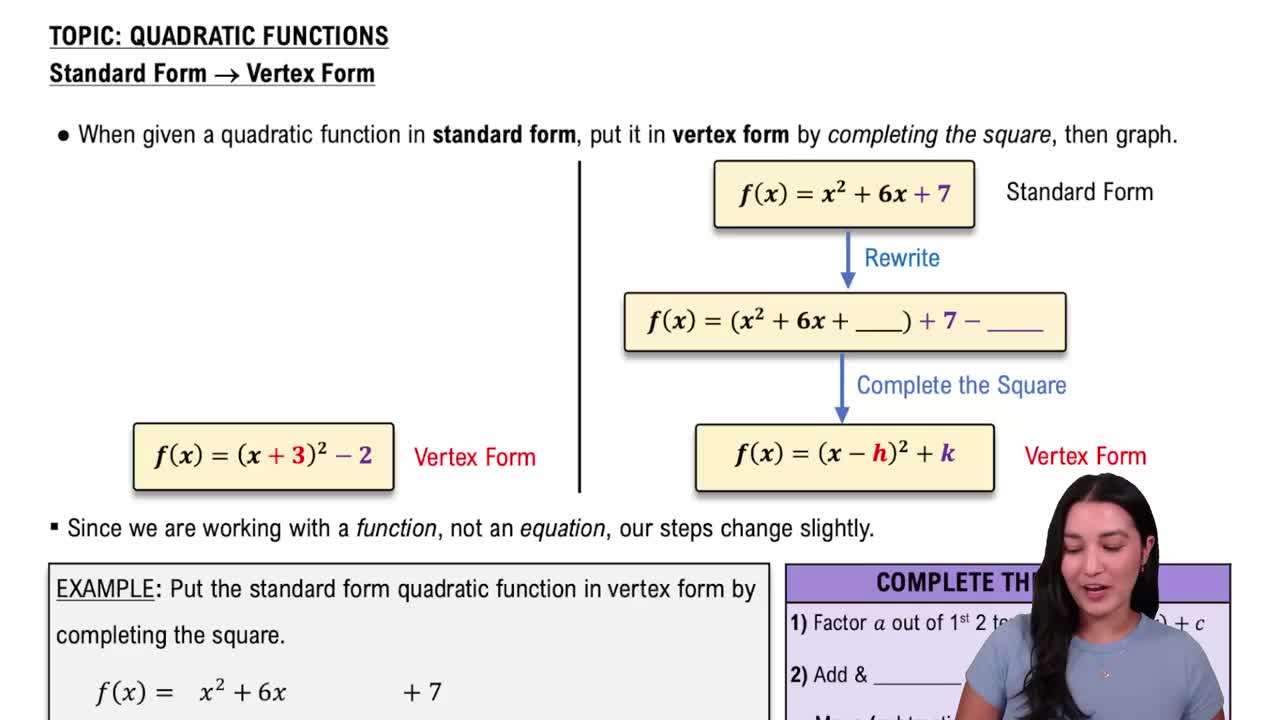Table of contents
- 0. Review of Algebra4h 16m
- 1. Equations & Inequalities3h 18m
- 2. Graphs of Equations43m
- 3. Functions2h 17m
- 4. Polynomial Functions1h 44m
- 5. Rational Functions1h 23m
- 6. Exponential & Logarithmic Functions2h 28m
- 7. Systems of Equations & Matrices4h 6m
- 8. Conic Sections2h 23m
- 9. Sequences, Series, & Induction1h 19m
- 10. Combinatorics & Probability1h 45m
4. Polynomial Functions
Quadratic Functions
Problem 2
Textbook Question
In Exercises 1–4, use the vertex and intercepts to sketch the graph of each quadratic function. Give the equation for the parabola's axis of symmetry. Use the graph to determine the function's domain and range. f(x) = (x + 4)^2 - 2
 Verified step by step guidance
Verified step by step guidance1
Identify the vertex of the quadratic function. The function is in vertex form \( f(x) = (x + 4)^2 - 2 \), where the vertex \( (h, k) \) is \( (-4, -2) \).
Determine the axis of symmetry. The axis of symmetry for a parabola in vertex form \( f(x) = (x - h)^2 + k \) is \( x = h \). Therefore, the axis of symmetry is \( x = -4 \).
Find the x-intercepts by setting \( f(x) = 0 \) and solving for \( x \). This involves solving the equation \( (x + 4)^2 - 2 = 0 \).
Find the y-intercept by evaluating \( f(x) \) at \( x = 0 \). Substitute \( x = 0 \) into the function to find \( f(0) \).
Determine the domain and range. The domain of any quadratic function is all real numbers. The range is determined by the vertex and the direction of the parabola. Since the parabola opens upwards, the range is \( y \geq -2 \).
Recommended similar problem, with video answer:
 Verified Solution
Verified SolutionThis video solution was recommended by our tutors as helpful for the problem above
Video duration:
11mPlay a video:
Was this helpful?
Key Concepts
Here are the essential concepts you must grasp in order to answer the question correctly.
Vertex of a Quadratic Function
The vertex of a quadratic function is the highest or lowest point on the graph, depending on the direction of the parabola. For the function f(x) = (x + 4)^2 - 2, the vertex can be found directly from the vertex form of a quadratic equation, which is f(x) = a(x - h)^2 + k, where (h, k) is the vertex. In this case, the vertex is at (-4, -2).
Recommended video:

Vertex Form
Axis of Symmetry
The axis of symmetry for a quadratic function is a vertical line that divides the parabola into two mirror-image halves. It can be determined using the formula x = h, where h is the x-coordinate of the vertex. For the given function, the axis of symmetry is x = -4, indicating that the parabola is symmetric about this line.
Recommended video:

Properties of Parabolas
Domain and Range of Quadratic Functions
The domain of a quadratic function is the set of all possible x-values, which is typically all real numbers for parabolas. The range, however, depends on the vertex; if the parabola opens upwards, the range starts from the y-coordinate of the vertex to positive infinity. For f(x) = (x + 4)^2 - 2, the domain is all real numbers, while the range is [-2, ∞) since the vertex is the minimum point.
Recommended video:

Domain & Range of Transformed Functions

 7:42m
7:42mWatch next
Master Properties of Parabolas with a bite sized video explanation from Callie
Start learningRelated Videos
Related Practice











